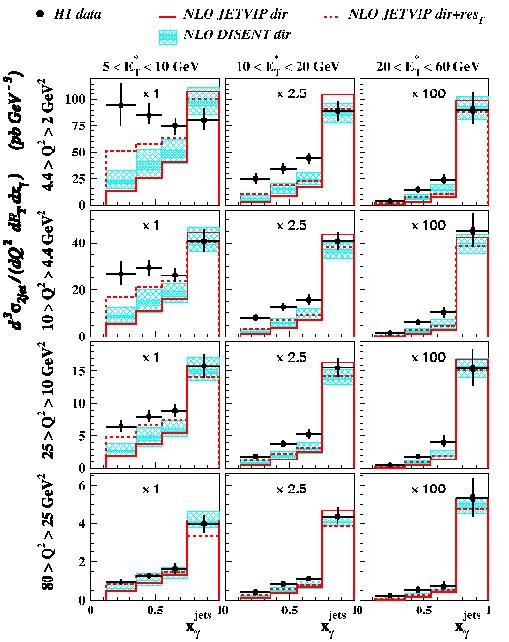
Measurement of Dijet Production
|
The interactions of real and virtual photons with the quarks and gluons (partons) that make up the proton are described theoretically by quantum chromodynamics (QCD), for which calculations are typically available up to next-to-leading order (NLO) in the strong coupling constant alphas. In a number of previous H1 papers, cross sections for the production of high transverse momentum jets of hadrons in electron proton collisions at HERA have been compared with NLO QCD calculations. At large Q2, the virtuality of the photon exchanged between the electron and a parton in the proton, NLO calculations which treat the photon as a point-like object are highly successful in describing the data. In the `photoproduction' region (Q2 ~ 0), it is well known that the photon exhibits hadron-like properties in its interactions and has to be treated as itself containing quarks and gluons. A `resolved' component of the photon thus has to be added to the point-like `direct' component. This paper is concerned with the production of pairs of jets in the region of low to moderate Q2, between the two extremes of point-like and hadron-like photon behaviour. In this kinematic domain, it has previously been shown that NLO QCD predictions for direct photons do not reproduce the data satisfactorily in some regions. Better descriptions have been obtained by ascribing partonic structure to the virtual, as well as the real, photon. Resolved virtual photons then play a role where Q2 is small compared with other measures of the scales resolved in the interaction, such as the squared jet transverse energy ET2. Here, we systematically test all available perturbative QCD calculations in order to identify which of them are successful in which phase space regions. In doing that, we use NLO QCD calculations and leading order (LO) Monte Carlo programs, which provide different approximations to higher order QCD effects and which are able to simulate resolved virtual photon contributions.
The observable xgamma provides a measure of the fraction of
the photon momentum that participates in the production of the jets.
This fraction is expected to be close to 1 for direct photon interactions and
significantly less than 1 for resolved photon interactions. The figure
shows the dijet cross section as a function of xgamma for different
regions of Q2 and ET. The
measured cross section in the `resolved'
low xgamma region is substantial at low Q2 and
ET.
The hatched band and the full line show two NLO QCD
predictions that neglect the structure of the virtual photon.
These calculations describe the data well for
large Q2 and large ET. However, they do not reproduce
the large measured cross section
at low Q², low ET and low xgamma.
The dashed line shows an NLO QCD prediction
which attempts to take into account the resolved photon component.
The inclusion of the resolved photon contribution,
which effectively resums part of the higher-order QCD terms associated
with photon splittings, brings
the NLO QCD calculations closer to the data, though there is
still a deficit at low xgamma, low Q² and low ET.

The inclusion of QCD parton showers in LO Monte Carlo models, which take into account part of the higher-order (the so called leading logarithmic) QCD terms, leads to a considerable improvement in the description of the data (see the publication).
Although the real photon only exists with transverse polarisation due to gauge invariance, at large Q2, the photon can also be longitudinally polarised. Until recently, the longitudinal photon contribution was neglected in calculations of resolved photon interactions. In this publication, longitudinally polarised resolved virtual photons are included in a LO Monte Carlo prediction, which leads to the best agreement with the data.
The measurement is also compared with the Monte Carlo program CASCADE, based on the CCFM evolution scheme and `unintegrated' parton density functions of the proton. Due to its different structure of parton emissions from the standard DGLAP approach, CCFM evolution is able to generate large cross sections at small xgamma without explicitly including resolved virtual photons. The CASCADE predictions describe the main qualitative trends in the data, except the Q² dependence at low ET or low xgamma.
To conclude, the data show clear evidence for effects that go beyond the fixed-order NLO QCD calculations, which, at least in part, can be reproduced with LO Monte Carlo models that include resolved virtual photon structure.